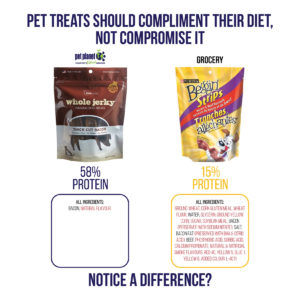Poor quality pet foods may cost less at the register but cost more in long-term care
 An important aspect of good nutrition often overlooked is the choice of pet treats.
An important aspect of good nutrition often overlooked is the choice of pet treats.
Giving little thought to the quality of treats you are feeding your pets really defeats the purpose of feeding a high-quality pet food, which you’ve taken the time to carefully select.
While most consumers have educated themselves about what constitutes a good quality pet food—protein listed as the first ingredient and no by-products, etc.—many don’t even think twice about grabbing a bag of treats from the grocery store shelf and throwing it in their cart. Unfortunately, this lack of thought may be harming your pet more than you realize. Low-quality treats containing low-quality ingredients have been linked to digestive upset and allergies.
There are many great healthy treats available today that will not harm your pet. Following the same simple guidelines when shopping for treats as you do for pet food is imperative. Look for high-quality protein sources, and avoid certain ingredients that can compromise your pet’s good health.
| INGREDIENT TYPE | INGREDIENTS TO AVOID | HEALTHY INGREDIENTS |
| Protein Source
|
• By-products • “Meat” Meals
• Soybean Meal • Blood or Bone Meal |
Fresh meats, like chicken, lamb, turkey, duck, beef and salmon.
Chicken meal, lamb meal, beef meal and salmon meal, etc. Organ meats, such as liver, kidney, lung and tripe. |
| Carbohydrate Source | • Cellulose • Oat Hulls • Wheat Middlings | Fruits, Vegetables, Barley, Oatmeal, Rye |
| Fat Source | • Animal Fat
• Beef Tallow • Lard |
Salmon (fish) oil and flaxseeds are the best, as they are a source of Omega 3 fatty acids, excellent for healthy skin and coat and a strong antioxidant.
Chicken fat Duck fat |
| Preservative Source | • BHA • BHT • Ethoxyquin
All three of the above are chemical preservatives linked to cancer, kidney disease, allergies and immunodeficiencies. |
Mixed Tocopherols are best, as these are natural preservatives and can contain any combination of vitamin E, vitamin C and rosemary extract. |
| Humectant Source (used to maintain the semi-moist consistency of soft treats) | • Propylene Glycol—a derivative of antifreeze. Exposure can be toxic and long-term ingestion is linked to cancer. | Vegetable Glycerin |
| Additives | • Artificial Coloring—avoid any dyes, such as yellow 5, red 40, blue 2, etc. | |
| Sweeteners | • Fructose • Corn Syrup
• Sugar • Sorbitol |
|
| Flavoring Agents | • Animal digest | Natural flavors, such as peanut butter and cheese, etc. |

